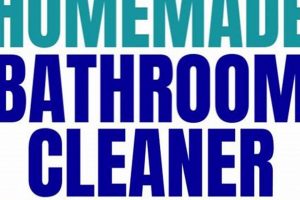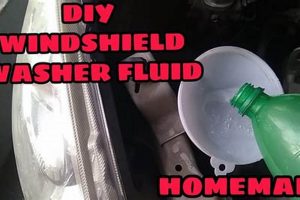A homemade blend designed for cleaning carpets represents an alternative to commercially manufactured cleaning products. This mixture, typically composed of common household ingredients, serves the purpose of removing dirt, stains, and odors embedded within carpet fibers. For instance, a solution might include a combination of water, vinegar, and baking soda to create a cleansing agent.
The appeal of formulating personalized carpet cleaners lies in cost-effectiveness, environmental consciousness, and control over the ingredients used. Choosing readily available substances can reduce expenses associated with professional cleaning services or specialized cleaning agents. Furthermore, these formulations often avoid harsh chemicals present in some commercial products, presenting a gentler option for both the environment and individuals sensitive to chemical irritants. Historically, homemade remedies were the primary means of carpet care before the widespread availability of manufactured cleaning products.
The subsequent sections will detail effective recipes, application techniques, and safety precautions relevant to creating and utilizing these homemade carpet cleaning options. These details will empower individuals to maintain clean and fresh carpets using readily available and manageable resources.
Essential Considerations for Homemade Carpet Cleaning
The following guidelines ensure optimal results and safety when employing homemade solutions for carpet maintenance.
Tip 1: Pre-Treatment is Crucial: Prior to applying any solution, conduct a thorough vacuuming to eliminate loose debris and surface dirt. This step optimizes the solution’s contact with embedded stains.
Tip 2: Test in an Inconspicuous Area: Apply a small amount of the solution to a hidden section of the carpet, such as under furniture or in a closet, and observe for discoloration or damage over a 24-hour period. This precaution prevents widespread damage from incompatible formulas.
Tip 3: Use Distilled Water: Opt for distilled water in the solution preparation. Tap water contains minerals that can leave residue or alter the effectiveness of certain ingredients.
Tip 4: Avoid Over-Saturation: Apply the solution sparingly. Excess moisture can penetrate the carpet padding, leading to mold growth and prolonged drying times. Use a spray bottle or lightly dampened cloth.
Tip 5: Ensure Proper Ventilation: Maintain adequate airflow in the room during and after cleaning. Open windows and use fans to accelerate the drying process and prevent moisture buildup.
Tip 6: Neutralize Odors Effectively: Incorporate natural odor neutralizers, such as baking soda or essential oils (used sparingly and with caution), into the solution. These can help eliminate lingering smells embedded in the carpet fibers.
Tip 7: Blot, Do Not Rub: When addressing stains, blot the affected area with a clean cloth. Rubbing can spread the stain and damage the carpet fibers.
Implementing these tips enhances the efficacy and safety of homemade carpet cleaning methods, promoting a cleaner and healthier living environment.
The concluding section will summarize the key considerations for successful and safe homemade carpet care.
1. Ingredient Selection
The composition of a homemade carpet cleaning formulation is paramount to its success and safety. The selection of each component dictates the solution’s cleaning power, its potential impact on carpet fibers, and the overall environmental profile of the cleaning process.
- Cleaning Agent Efficacy
The primary function of a homemade cleaning solution rests upon its active cleaning agents. Ingredients like vinegar, baking soda, and hydrogen peroxide possess distinct cleaning properties. Vinegar, for instance, exhibits acidity that aids in dissolving alkaline residues and neutralizing odors. Baking soda acts as a mild abrasive and deodorizer. The choice of these agents dictates the solution’s ability to lift stains and remove dirt effectively. Incorrect selection may result in ineffective cleaning or, worse, setting the stain further.
- Material Compatibility
Carpets are manufactured from various materials, including natural fibers such as wool and synthetic fibers like nylon and polyester. Certain ingredients are more compatible with specific fiber types than others. High concentrations of acidic solutions, for example, can damage wool fibers. Thus, selecting ingredients that are compatible with the carpet’s material is crucial to prevent discoloration, fiber degradation, or premature wear. Failure to consider material compatibility can lead to irreversible damage to the carpet.
- Safety Profile
The safety of both the user and the environment is a significant consideration. Many commercial cleaning products contain harsh chemicals that pose risks to human health and contribute to environmental pollution. Homemade solutions offer the potential to mitigate these risks by using safer alternatives. However, even natural ingredients can present hazards if not handled correctly. For instance, concentrated essential oils can irritate skin and respiratory systems, and improper mixing of certain ingredients can create toxic fumes. Therefore, careful consideration of each ingredient’s safety profile is essential to ensure a safe and healthy cleaning process.
- Residue Potential
Some ingredients, while effective at cleaning, may leave undesirable residues behind. Soap-based solutions, for instance, can leave a sticky residue that attracts dirt over time, leading to accelerated resoiling. Similarly, excessive use of baking soda may result in a powdery residue. Choosing ingredients with minimal residue potential, or incorporating a rinsing step to remove residues, is critical for maintaining the long-term cleanliness and appearance of the carpet.
Ultimately, the careful selection of ingredients directly influences the effectiveness, safety, and longevity of the “diy carpet shampoo solution”. A thorough understanding of each ingredient’s properties and potential effects is essential for achieving optimal results and safeguarding both the carpet and the environment.
2. pH Balance
The pH level of a homemade carpet cleaning solution is a crucial determinant of its efficacy and potential impact on carpet fibers. Maintaining an appropriate pH is essential to avoid damaging the carpet while effectively removing dirt and stains. Understanding the pH scale, ranging from acidic to alkaline, is fundamental when formulating these solutions.
- Fiber Degradation
Extreme pH levels, whether highly acidic or highly alkaline, can lead to the degradation of carpet fibers. Natural fibers, such as wool, are particularly susceptible to damage from alkaline solutions, which can cause the fibers to become b
rittle and weaken. Synthetic fibers may also be affected by extreme pH levels, leading to discoloration or structural damage. Maintaining a neutral or slightly acidic pH minimizes the risk of fiber damage. - Stain Removal Efficacy
The pH of a cleaning solution can influence its ability to remove different types of stains. Acidic stains, such as coffee or red wine, may be more effectively removed by alkaline solutions, while alkaline stains, such as grease or soap residue, may respond better to acidic solutions. However, the pH must be carefully balanced to avoid damaging the carpet fibers while targeting the stain effectively. Overly acidic or alkaline solutions can set stains further or cause irreversible damage.
- Residue Buildup
Improperly balanced pH levels can contribute to residue buildup in carpet fibers. Alkaline cleaning solutions, if not thoroughly rinsed, can leave a soapy residue that attracts dirt over time, leading to accelerated resoiling. Similarly, acidic solutions can leave a sticky residue that can attract allergens and pollutants. Ensuring a balanced pH and proper rinsing is essential to prevent residue buildup and maintain the long-term cleanliness of the carpet.
- Safety and Irritation
Solutions with extreme pH levels can pose safety risks to the user, causing skin irritation, respiratory problems, or eye damage upon contact. Acidic solutions can cause chemical burns, while alkaline solutions can cause skin dryness and irritation. Using a pH-balanced solution minimizes the risk of these adverse effects, promoting a safer and more comfortable cleaning experience.
The relationship between pH balance and homemade carpet cleaning solutions underscores the importance of careful formulation and application. Precise measurement and adjustment of pH levels are necessary to ensure the solution is both effective and safe for the user and the carpet. Testing in an inconspicuous area before widespread application is a critical step to avoid potential damage.
3. Stain Specificity
The effectiveness of any “diy carpet shampoo solution” is intrinsically linked to the principle of stain specificity. The composition of a stain, whether oil-based, water-based, or enzymatic, dictates the appropriate cleaning agent required for its successful removal. Applying a universal cleaning solution without regard to the stain’s nature often results in incomplete removal or, in some cases, permanent setting of the stain. For instance, an oil-based stain, such as grease or cooking oil, necessitates a solvent-based solution to break down the hydrophobic bonds, whereas a water-based stain, like coffee or juice, may respond effectively to an absorbent or mild detergent. The cause-and-effect relationship is direct: accurate identification of the stain type allows for the selection of a targeted solution, leading to enhanced cleaning outcomes.
Stain specificity in “diy carpet shampoo solution” formulation highlights the importance of understanding basic chemistry principles. A tannin stain, common from tea or wine, requires an acidic solution to neutralize the alkaline components responsible for the discoloration. Conversely, protein-based stains, such as blood or milk, necessitate enzymatic cleaners that break down the complex protein molecules. A practical example is the application of a baking soda paste for odor absorption, effective for neutralizing lingering smells, but ineffective in removing greasy residues. Likewise, vinegar, an acid, may remove hard water spots effectively, yet it is unsuitable for dissolving alkaline stains like dried paint. Recognizing these distinctions is crucial for avoiding ineffective treatments and preventing further damage to the carpet fibers.
In summary, stain specificity is a cornerstone of successful homemade carpet cleaning. The selection of appropriate cleaning agents, tailored to the specific type of stain, is essential for achieving optimal results and preserving the carpet’s integrity. The challenge lies in accurately identifying the stain and understanding the chemical properties of available cleaning agents. Overcoming this challenge requires a basic understanding of stain chemistry and the careful application of targeted solutions, ensuring efficient stain removal without causing harm to the carpet. A deep understanding of stain specificity offers an effective pathway to resolving unique cleaning challenges, while saving money and preventing damage.
4. Application Method
The effectiveness of any “diy carpet shampoo solution” is significantly contingent upon the method of application. Even the most carefully formulated cleaning mixture can yield unsatisfactory results if improperly applied. The application method dictates the distribution of the solution, the depth of penetration into the carpet fibers, and the eventual removal of loosened dirt and residues. For instance, simply pouring a solution onto a stain may lead to over-saturation and inadequate extraction, potentially fostering mold growth or leaving behind a sticky residue. Conversely, using a stiff brush with excessive force can damage delicate carpet fibers, irrespective of the solution’s composition. The correlation is clear: the application method must align with the type of solution and the nature of the stain to optimize cleaning outcomes.
Various application methods are available, each suited to different scenarios. A spray bottle offers controlled distribution for targeted stain treatment, minimizing the risk of over-saturation. A dampened microfiber cloth allows for gentle blotting and absorption, ideal for delicate fabrics or light surface cleaning. Carpet cleaning machines, either rented or purchased, provide deeper cleaning action with integrated extraction capabilities. The choice of method should consider the size of the affected area, the severity of the stain, and the carpet’s material. For example, a large area requiring overall cleaning would benefit from a carpet cleaning machine, whereas a small, localized stain might be effectively treated with a spray bottle and blotting technique. Failure to select the appropriate method can lead to ineffective cleaning, fiber damage, or prolonged drying times.
In conclusion, the application method is an indispensable component of a successful “diy carpet shampoo solution.” It influences the solution’s effectiveness, minimizes potential damage to the carpet, and ensures proper removal of dirt and residues. The right method allows for optimal distribution, penetration, and extraction. Challenges, therefore, include selecting the right method and using that method correctly. The practical significance of understanding this connection lies in the ability to maximize the benefits of homemade cleaning solutions while safeguarding the investment in carpet. Understanding and applying the optimal method is essential for ensuring a clean carpet.
5. Residue Removal
The effectiveness of any “diy carpet shampoo solution” is incomplete without diligent residue removal. The intentional application of a cleaning mixture invariably leaves behind remnants of its constituent ingredients within the carpet fibers. These residues, if not thoroughly extracted, act as attractants f
or dirt and grime, accelerating the resoiling process and diminishing the carpet’s appearance. The presence of residue can also impact the texture and feel of the carpet, creating a stiff or sticky sensation. For instance, if a baking soda paste is used for odor absorption, but not adequately vacuumed, a white powdery film persists, dulling the carpet’s color. The consequence is a carpet that appears clean initially but degrades rapidly over time due to accumulated soil bound to the residual cleaning agents. The effect highlights that the removal of cleaning agents is a significant and key component of a total “diy carpet shampoo solution”.
The techniques employed for residue removal vary depending on the nature of the cleaning solution used. Thorough vacuuming is essential for removing dry residues, such as baking soda or powdered detergents. Wet extraction methods, involving the use of a carpet cleaning machine with clean water, are effective for flushing out liquid-based residues, such as soap or vinegar solutions. The number of rinsing passes necessary depends on the concentration of the original cleaning solution and the fiber type of the carpet. Consider a scenario where a homemade soap-based solution is used; without thorough rinsing, the soap residue attracts dirt, causing the carpet to appear dingy and feel matted within weeks. This process demonstrates the crucial role of residue removal to maintain the long-term cleanliness.
In summary, residue removal is an indispensable step in the proper execution of “diy carpet shampoo solution” techniques. The long-term cleanliness and appearance of the carpet is depending on residue removal after any cleaning method. The application itself it just the first step on a journey of cleaning a dirty carpet. Without adequate removal of cleaning agents, the carpet is doomed to attract more dirt than usual. The challenge lies in selecting the appropriate removal technique and dedicating sufficient effort to ensure complete extraction. Proper cleaning is not just about cleaning but about removing the cleaning methods and their ingredients completely.
6. Drying Time
The duration required for a carpet to dry following the application of a homemade cleaning mixture represents a critical factor influencing the overall success and practicality of the cleaning process. Prolonged drying times create an environment conducive to mold and mildew growth within the carpet fibers and padding. This, in turn, poses potential health risks to occupants and compromises the integrity of the carpet itself. For instance, a carpet that remains damp for more than 24-48 hours provides an ideal breeding ground for mold spores, leading to musty odors and potential allergic reactions. The correlation between drying time and the health and longevity of the carpet underscores its importance as a key consideration in homemade carpet cleaning practices. The type of mixture, weather conditions and ventilation play a critical role in a faster drying time of the carpet.
Factors influencing drying time include the volume of liquid applied, the ambient humidity, and the degree of ventilation within the room. Over-saturation of the carpet during cleaning directly contributes to extended drying times. Similarly, high humidity levels impede evaporation, prolonging the drying process. Inadequate ventilation restricts airflow, hindering moisture removal from the carpet fibers. Practical applications include employing fans or dehumidifiers to expedite drying. Utilizing a wet/dry vacuum to extract excess moisture after cleaning also significantly reduces drying time. Proper ventilation can speed up the drying process for a couple of hours by a simple open windows activity. Ignoring any of the above factors leads to slow drying and all the negative side effects mentioned before.
In summary, drying time is an essential element in the comprehensive execution of any “diy carpet shampoo solution.” Overlooking this aspect can negate the benefits of the cleaning process and potentially create adverse consequences. The challenges associated with managing drying time include balancing cleaning efficacy with minimizing moisture application, controlling environmental factors, and employing appropriate drying techniques. Understanding the interconnectedness of these elements is essential for maximizing the effectiveness of homemade carpet cleaning methods while safeguarding the health and longevity of the carpet.
7. Carpet Fiber
Carpet fiber composition is a primary determinant of the suitability and efficacy of any “diy carpet shampoo solution.” The chemical and physical properties of the fiber dictate its response to cleaning agents, influencing both stain removal and potential damage. Understanding these properties is essential for selecting appropriate cleaning methods and preventing irreversible harm to the carpet.
- Natural Fiber Sensitivity
Natural fibers, such as wool and cotton, exhibit a higher sensitivity to alkaline cleaning solutions compared to synthetic fibers. Alkaline substances can cause the scales on wool fibers to open, leading to felting, shrinkage, and a loss of luster. Cotton fibers, while more resilient, can still experience discoloration or weakening from prolonged exposure to strong alkaline solutions. For natural fiber carpets, pH-neutral or mildly acidic cleaning solutions are generally recommended to maintain their integrity and prevent damage.
- Synthetic Fiber Resilience
Synthetic fibers, including nylon, polyester, and olefin, generally demonstrate greater resistance to a wider range of chemical cleaning agents. Nylon, known for its durability and stain resistance, can withstand more aggressive cleaning solutions than natural fibers. Polyester and olefin are hydrophobic, meaning they repel water, making them inherently more stain-resistant. However, even synthetic fibers can be damaged by harsh chemicals or abrasive cleaning methods. Careful consideration of the specific synthetic fiber type and the cleaning solution’s compatibility is still necessary.
- Dye Stability
The dye used to color carpet fibers can react differently to various cleaning agents. Certain dyes are more susceptible to fading or bleeding when exposed to specific chemicals or pH levels. This is especially relevant for brightly colored or patterned carpets. Before applying any homemade cleaning solution, it is crucial to test its effect on the dye in an inconspicuous area to prevent irreversible discoloration. Mild, pH-neutral solutions are generally safer for maintaining dye stability, regardless of fiber type.
- Fiber Structure and Soil Release
The physical structure of carpet fibers influences their ability to release soil and resist staining. Fibers with a smooth surface tend to repel dirt more effectively than those with a rough or textured surface. Certain synthetic fibers are treated with stain-resistant coatings to enhance their soil-release properties. Homemade cleaning solutions that contain surfactants can aid in loosening soil particles and suspending them in water for easier removal. However, over-application of certain cleaning agents can leave behind a residue that attracts dirt, negating the benefits of the initial cleaning.
In conclusion, the selection and application of “diy carpet shampoo solution” must be tailored to the specific characteristics of the carpet fiber. Ignoring the fiber’s composition and properties can result in ineffec
tive cleaning, irreversible damage, or accelerated resoiling. Understanding these factors is essential for achieving optimal cleaning results while preserving the integrity and appearance of the carpet.
Frequently Asked Questions
The following questions address common concerns and provide informative answers regarding the use of homemade carpet cleaning solutions.
Question 1: Are homemade carpet cleaning solutions as effective as commercial products?
Effectiveness depends on the specific stain, carpet fiber, and the formulation of the homemade solution. While some homemade solutions can be highly effective for certain stains, commercial products are often formulated with specialized chemicals for broader stain removal capabilities.
Question 2: Can “diy carpet shampoo solution” damage my carpet?
Improperly formulated or applied homemade solutions can indeed damage carpets. High acidity or alkalinity can degrade fibers, while excessive moisture can promote mold growth. Testing in an inconspicuous area is crucial.
Question 3: What are the essential ingredients for a basic homemade carpet cleaning solution?
Commonly used ingredients include water, vinegar, baking soda, and mild dish soap. The specific proportions vary depending on the stain and carpet type. Distilled water is preferred to minimize residue.
Question 4: How can I ensure a homemade carpet cleaning solution is safe for my pets and children?
Carefully select ingredients known to be non-toxic. Essential oils, if used for fragrance, should be used sparingly and with caution, as some can be harmful to animals. Thoroughly ventilate the area during and after cleaning.
Question 5: How do I remove stubborn stains with homemade carpet cleaning solutions?
Pre-treating the stain is crucial. Identify the stain type and use a solution specifically formulated for that type. Blot, do not rub, and allow the solution to dwell for several minutes before extracting.
Question 6: How often should I clean my carpets with a “diy carpet shampoo solution”?
Frequency depends on traffic and soiling. General cleaning is recommended every 6-12 months, while spot cleaning should be performed as needed. Over-cleaning can lead to premature wear and residue buildup.
Proper formulation, careful application, and thorough residue removal are key to successful homemade carpet cleaning. Always prioritize safety and test the solution before widespread use.
The concluding section summarizes the overall benefits and drawbacks of using “diy carpet shampoo solution.”
diy carpet shampoo solution
The preceding exploration of “diy carpet shampoo solution” highlights its multifaceted nature. Successfully employing these homemade mixtures demands careful consideration of stain specificity, carpet fiber composition, pH balance, application techniques, residue removal, and drying time. While cost-effectiveness and control over ingredients are attractive features, the potential for damage due to improper formulation or application remains a significant concern.
The information presented equips individuals to make informed decisions regarding carpet care. Whether opting for commercially available products or attempting a “diy carpet shampoo solution”, understanding the underlying principles of stain removal and carpet fiber interaction is paramount. Responsible application, informed by knowledge and caution, is essential to preserving the integrity and extending the lifespan of valuable floor coverings.





![DIY Build: Circular Saw Crosscut Jig PDF Plans [Free] The DIY Hub: Creative Crafts, Repairs & Life Hacks DIY Build: Circular Saw Crosscut Jig PDF Plans [Free] | The DIY Hub: Creative Crafts, Repairs & Life Hacks](https://craftingdiycenter.com/wp-content/uploads/2025/07/th-5916-300x200.jpg)

